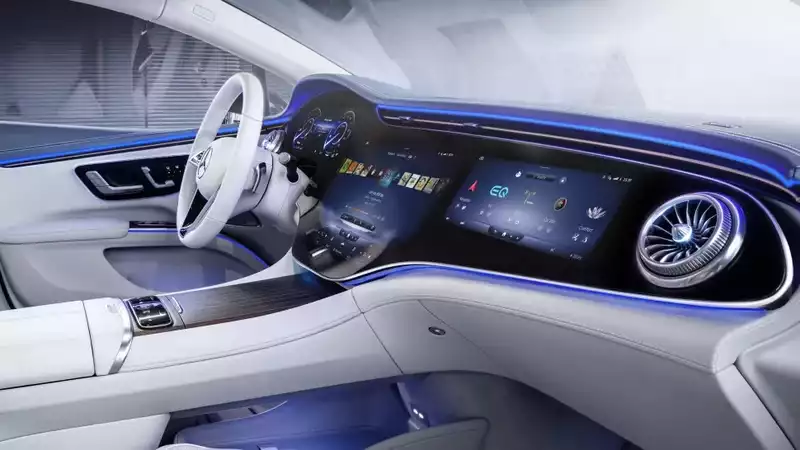The line between next-generation technology and cars is becoming increasingly blurred. This is especially true in the case of the Mercedes EQS electric car, which features a huge sci-fi interior display.
The new Mercedes EQS sedan, scheduled for release this August, already promises to be one of the most aerodynamic production cars ever, but its hyper-screen will be the killer feature of a car that will likely rank on our best electric cars list Likely.
The 56-inch hyperscreen extends from the driver's dashboard to the passenger side, effectively integrating three displays into one.
There is one 12.3-inch, 2400 x 900 digital instrument cluster for the driver, another for the passenger, and a 17.7-inch "co-driver" display that by default shows map information and is viewable by both driver and passenger.
Mercedes' MBUX infotainment platform, which effectively incorporated the infotainment display into the dashboard, provided a large screen.
This has the effect of looking a bit cleaner than the stand-alone infotainment displays found in today's cars, which look like an iPad stuck on top of the instrument cluster. In addition, the dashboard area displays the traditional speed and rev counters and provides the driver with more information than ever before, such as live camera images of the road ahead superimposed with navigation instructions.
New images of the EQS cabin show that the hyperscreen appears to be a significant extension of the MBUX platform.
First unveiled at CES 2021, the HyperScreen will offer a variety of information ranging from driver-centric displays to a range of entertainment, connectivity, and even social media content. Of course, such information can already be displayed in cars with two digital displays, but a single seamless panel composed of pOLED displays is cleaner looking and improves the interaction between the screens.
Hyperscreen can also provide information to the front passenger driver, who can adjust settings in the car and feedback navigation instructions to the driver.Many of the infotainment controls appear to be integrated into the touchscreen. We've driven several cars that have eliminated physical buttons in favor of digital controls and found them a bit cumbersome to adjust on the fly. Audi's MMI infotainment system, however, makes this a little easier by providing tactile feedback.
And the HyperScreen is also set to get tactile feedback and some AI technology to help provide information and functions intelligently to the driver and passengers.
These smart technologies may reduce scrolling and digging through sub-menus while driving, minimizing driver distraction and frustration from not finding the right settings on the fly.
In addition to this, support for Apple CarPlay and Android Auto is also expected. The system will also have the ability to automatically adjust the soundscape to match the way the car is driven. When driving at a sedate pace in city traffic, the pseudo-driving noise will be minimized.
However, as the driver presses down on the accelerator, more simulated sounds will fill the car, enhancing the sensation of driving feedback.
When it comes to performance, Mercedes has now confirmed that the EQS offers a range of up to 478 miles. It is also expected to have fast-charging technology that will provide a range of 180 miles in 15 minutes and a top speed of 130 mph provided by a rear-wheel drive or all-wheel drive system.
One advantage the EQS has over other EVs is its drag coefficient of 0.20. This means that they will be the most aerodynamic cars produced at full scale. Less aerodynamic drag means faster, more efficient EVs.
How these aerodynamic characteristics will affect the design of the EQS is not yet entirely clear. A series of "spy shots" have revealed the overall profile of the car, but the camouflage obscures the details. Mercedes has shown off a dark profile image of the car, which also hides key design details.
As far as we know, the current S-Class and C-Class three-box designs have been avoided. However, the EQS is not aiming to be a hybrid-sedan-corp crossover. Rather, it aims for an arched form, viewed in profile, with the front rising smoothly toward the center of the car and sloping inward toward the rear.
In other words, the EQS seems to be designed to be reminiscent of the S-Class and CLS coupes, but with its own contours cut out.
With all these technologies coupled with an aerodynamic design and solid range, the EQS is not going to be cheap. Mercedes has not revealed the price of this eclectic sedan. We will have to wait and see what pricing the automaker settles on once the EQS goes on sale later this year.
.









Comments